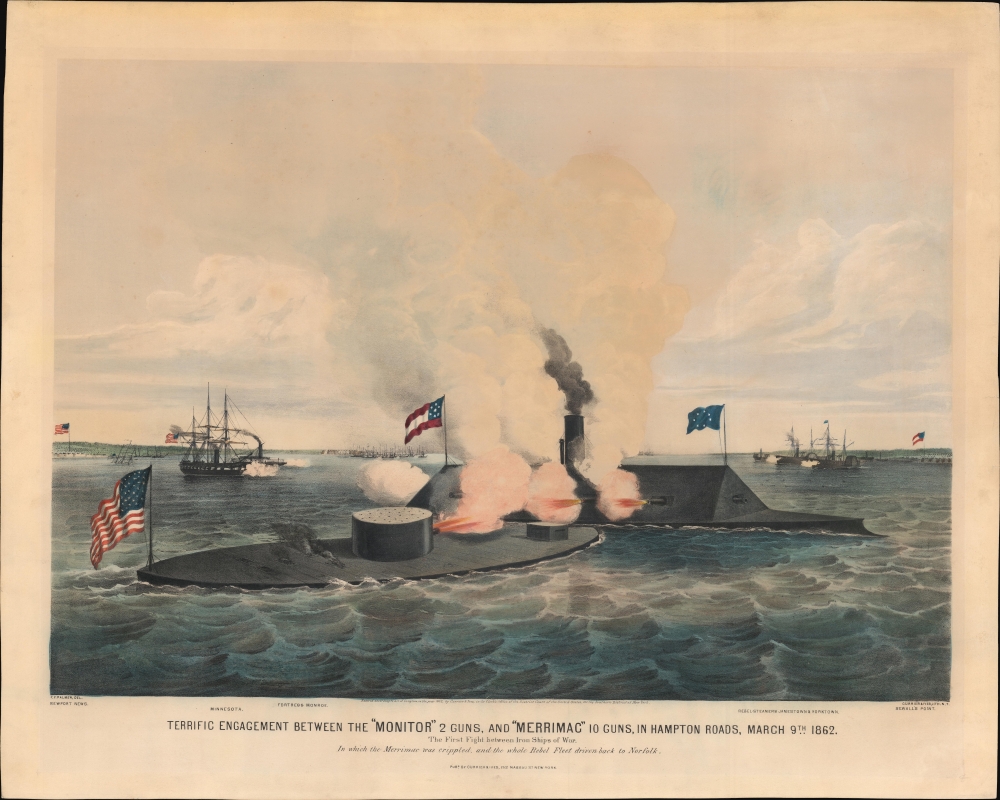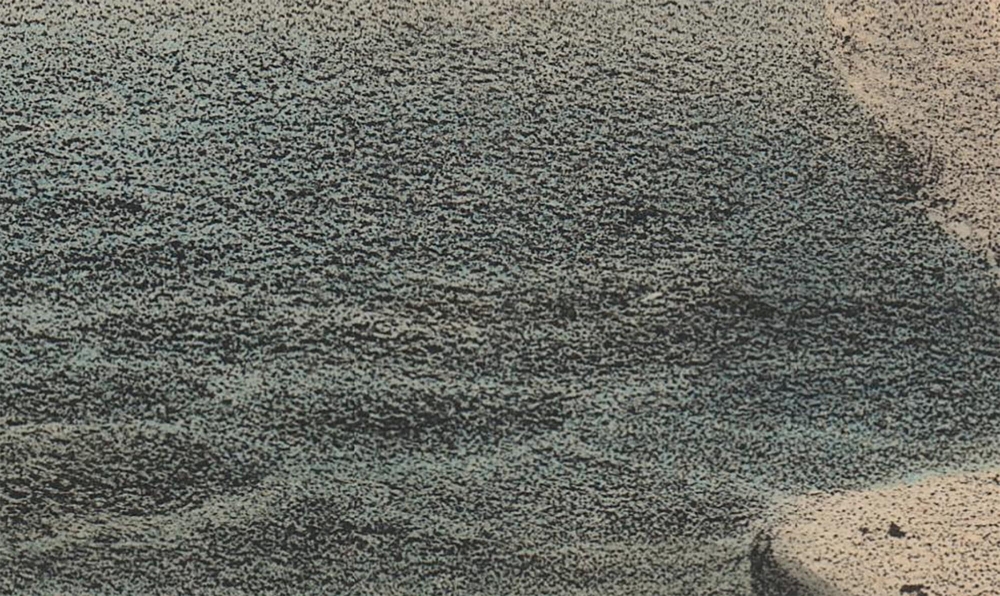1862 Currier and Ives View of the Civil War Battle of the 'Monitor' and 'Merrimac'
MonitorMerrimac-currierives-1862
Title
1862 (dated) 19.5 x 25 in (49.53 x 63.5 cm)
Description
A Closer Look
The view looks east from the James River toward the entrance to the Chesapeake Bay and the Atlantic. Union held Newport News is on the left, and Confederate held Sewall's Point, appears on the right. The clashing ironclads, USS Monitor and Merrimac, take center stage. The Monitor, with its novel rotating 2-gun turret is at the fore while the 10-gun Merrimac floats just behind. Both ironclads are firing at one another at point blank range. Despite the propagandist claims in the caption, neither ironclad could effectively harm the other, even at close range. The view features vivid original gauche color.Clash of Ironclads
The Battle of the Monitor and Merrimac, also known as the Battle of Hampton Roads, stands as a pivotal moment in naval history, occurring over two days on March 8-9, 1862, during the American Civil War. At Hampton Roads, Virginia, the Confederate Navy sought to challenge the Union blockade that was stifling the Southern economy and its ability to sustain the war. The Confederates repurposed the scuttled USS Merrimac, armoring it with iron and renaming it the CSS Virginia. On its maiden voyage, this fearsome ironclad obliterated two wooden Union warships, the USS Cumberland and the USS Congress, demonstrating the vulnerability of traditional wooden ships against armored opponents. The carnage might have continued if not for the timely arrival of the USS Monitor, a revolutionary Union ironclad with a rotating turret. On the second day, the two iron giants clashed, firing heavy shells at point-blank range but failing to inflict critical damage on one another. While neither side could claim a definitive victory, the engagement proved the concept of the 'ironclad', transforming naval combat thereafter. The supremacy of ironclad warships was clear, rendering wooden navies obsolete and ushering in a new era of naval warfare characterized by armored vessels and heavy artillery.Currier and Ives Prints
The New York publishing firm of Currier and Ives capitalized throughout the American Civil War by satisfying the insatiable consumer interest in the war with both large and small lithographs depicting dramatic events. The Battle of the Monitor and Merrimac fit the bill perfectly. The novel 'ironclad' technology was something that few had seen and its effectiveness against traditional canon fire caused an instant world-wide revolution. Although highly decorative, Currier and Ives prints were designed to be affordable to the average person, and were produced quickly in a factory-like manner in response to current events, making them 'in the moment' chronicles of the most important events of their time.In the subsequent 100+ years, Currier and Ives prints gained an immense following and, with the firm's closure, reproductions began appearing. This has led to considerable apprehension among collectors who rightly fear they may be buying a reproduction. In most cases, the original lithographic plates were destroyed, so the first step identifying an authentic piece is identifying the near-irreplicable pattern of a stone lithograph under high magnification. We are including an image of such for edification.
Publication History and Census
This view is based upon a painting by Frances Flora Palmer. It was issued in 1862 shortly after the events depicted by Currier and Ives. That firm, at the same time, also issued a much-reduced and cropped page-sized version of this view. Originals of this image are very rare. We note holdings at several art museums and libraries. It appears occasionally at auction, but from the existing auction descriptions, it is likely that most are reproductions.CartographerS
Nathaniel Currier (March 27, 1813 - November 20, 1888) was an American lithographer best known as part of 'Currier and Ives'. Born in Roxbury, Massachusetts, Currier attended public schools until fifteen, when he apprenticed with the Boston lithographic firm of William and John Pendleton. The Pendletons were the first successful lithographers in the United States and were responsible for educating the next generation of lithographic printers. In 1833, Currier left the Pendleton's shop to work with M.E.D. Brown in Philadelphia. A year later, Currier moved to New York City, where he planned to start a business with John Pendleton. When Pendleton backed out, Currier found a new partner, founding 'Currier and Stodart', but the concern survived for just a year. Currier opened his own lithographic studio in 1835 as an eponymous sole-proprietorship. He initially printed the standard materials, including letterheads, sheet music, and handbills. Later in 1835, Currier began issuing current event imagery. Some of his news printers were issued in the New York Sun. By 1840, Currier had moved away from 'job printing' and further toward fine-print publishing. His Awful Conflagration of the Steam Boat 'Lexington', was published in the Sun that year, as well as being separately issued. James Ives (March 5, 1824 - January 3, 1895) began working under Currier in 1850 as a bookkeeper. Ives contributed greatly to the growth of the business, particularly as a manager, marketer, and businessman. Ives became a full partner in 1857, and the firm was renamed 'Currier and Ives'. Currier and Ives produced over 7,500 images and is best remembered for its popular art prints, particularly Christmas scenes and landscapes. They also produced banners, illustrations of current events, views, and historical scenes. Currier retired in 1880 and turned the business over to his son Edward. Currier married Eliza West Farnsworth in 1840, with whom he had one child Edward West Currier. Eliza died in 1843. Currier remarried to Lura Ormsbee in 1847. Other than being a lithographer, Currier also served as a volunteer New York City fireman during the 1850s, and he liked fast horses. More by this mapmaker...
James Merritt Ives (March 5, 1824 - January 3, 1895) was an American businessman, bookkeeper, and lithographer who oversaw the business side of the famed lithographic firm Currier and Ives. Born in New York City, Ives was a self-trained artist who began working at the age of twelve. He married Caroline Clark (1827 - 1896) on June 24, 1846, who was the sister-in-law of Nathaniel Currier's brother, Charles Currier. In 1852, Nathaniel Currier (March 27, 1813 - November 20, 1888) hired Ives as the bookkeeper for his firm N. Currier, Lithographer, on Charles's recommendation. Ives' talent for art and his knowledge of the artistic world soon became apparent to Currier, who valued his insights as well as the business acumen. Currier offered Ives a full partnership in 1857. They renamed the firm 'Currier and Ives' with Ives as the general manager. Ives began to play a role in selecting artists and prints to publish, and was responsible for pursuing publication of scenes of middle-class America that made the firm famous. After Ives died in 1895, his sons continued to work with Currier's son to manage the firm until it was liquidated in 1907. Learn More...
Frances Flora Bond Palmer (July 24, 1812 - August 20, 1876) was an American artist active in the mid-19th century. Palmer, or 'Fanny' as she was known, is considered the first female professional artist in the United States and is best known for her work with Currier and Ives. She was born 'Frances Flora Bond' in Leicester, England. She studied at the Mary Linwood school for ladies, receiving an excelling private school education. She married Edmund Seymour Palmer, a gentleman's manservant, in 1832. Edmund lost his work several years later and in 1842 the couple partnered to open a lithography firm. Fanny was the artist and lithographer, and Edmund worked as the printer. They produced several local interest views, but this business ultimately failed. The couple moved to the United States in 1844, settling in New York. There, they established F. and S. Palmer, another lithographic company, which also failed. It has been suggested that the repeated business failures were due to Edmund's excessive drinking. In 1851, Fanny took work with Nathaniel Currier (1813 - 1888) and continued with the company after 1857, when it became 'Currier and Ives'. They grew to become the most successful publisher of lithographic prints in mid-19th century America. Fanny was their top artist, producing more Currier and Ives’ prints than any other. She was the primary breadwinner of her family and when Edmund died after drunkenly falling down a flight of stairs, she was left alone to raise her children, an event Nathaniel Currier described as the 'best thing that ever happened to her'. She retired from Currier and Ives in 1868, aged 66, her images among the most popular and stunning of that firm's prodigious corpus. She died of tuberculosis on August 20, 1876 and was buried in the Green-Wood Cemetery in Brooklyn. Learn More...




